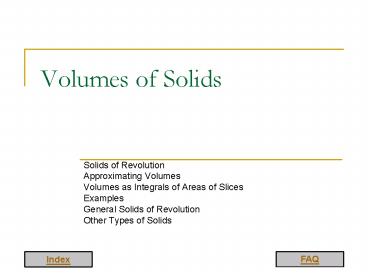Volumes of Solids - PowerPoint PPT Presentation
1 / 15
Title:
Volumes of Solids
Description:
Volumes of such solids of revolution can be computed by definite integrals in ... domain bounded by the line y=x and the parabola y=x2 rotate around the line y=x. ... – PowerPoint PPT presentation
Number of Views:162
Avg rating:3.0/5.0
Title: Volumes of Solids
1
Volumes of Solids
- Solids of Revolution
- Approximating Volumes
- Volumes as Integrals of Areas of Slices
- Examples
- General Solids of Revolution
- Other Types of Solids
2
Solids of revolution
Volumes of such solids of revolution can be
computed by definite integrals in the same way as
one computes areas of domains by integrals.
3
Approximating Volumes
The picture on the right shows a left rule
approximation of the domain bounded by the
function f. Letting the green boxes rotate
around the x-axis one gets an approximation of
the solid of revolution by cylinders.
The denser the (left rule) approximation of the
domain is, the better the approximation of the
solid (by cylinders) is.
Solid on the left, approximation on the right.
4
Riemann Sums for Volumes
Definition
5
Volumes as Integrals of Areas of Slices
The slice is obtained by slicing the solid by a
plane perpendicular to the x-axis and
intersecting the axis at the point x. The slice
is a disk of radius f(x). In the picture on the
right, the red curve is the graph of the function
f, x-axis is tilted down and y-axis is tilted
to the right.
6
Volume of a Ball
Example
7
Volume of a Torus (1)
Example
The volume of the torus thus formed has to be
computed in two steps.
8
Volume of a Torus (2)
9
Volume of a Torus (3)
10
Volume of a Torus (4)
Shortcut
11
General Solids of Revolution
In general, a solid of revolution is obtained
whenever a domain rotates around some line. The
same methods as before can be applied also in
such cases, but computations may become more
complicated.
As an example consider a solid of revolution
obtained by letting the domain bounded by the
line yx and the parabola yx2 rotate around the
line yx.
12
General Solids of Revolution (2)
13
Other Types of Solids
- Volumes of other types of solids can also be
computed by integration. The idea is to perform
the following - Slice the solids vertically along some straight
line going through the solid. - Express the area of the slice as a function of
the intersection point of the line and the slice. - Integrate this area function to find the volume
of the solid.
An example of this type of solid is the hat
above. It is a solid whose bottom face is a disk
with radius 1 and center at the origin, and whose
every cross section perpendicular to the x-axis
is a square. The volume of this solid can be
computed by suitable slicing of the solid.
14
Volume of the Hat
15
(No Transcript)































